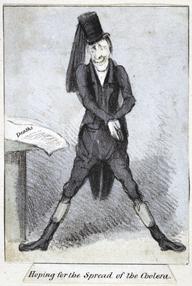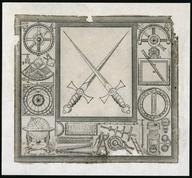

Paul Dury Sketchbook [3]:. 1. Ink and wash study of trees. 2. Jack Wilde sketch. 3. City view from wooded hillside in graphite. 4. [LOOSE] Ink sketches. 5. Pencil sketch of city skyline (possibly Battersea Power Station). [Newspaper clipping 'chronicle radio page 2' found here, now in T/ file]. 6. Two ink sketches of outdoor scene with urn on plinth. 7. Ink study for horley table. [Loose ministry of pensions paper found here now in T/ file]. 8. Pencil sketch for Horley Table. 9. Graphite sketch of cottage. 10. Ink sketches of bridge and 'bank under big tree'. 11. Ink sketch of trees, annotated. 12. Rough graphite sketch of cottages. 13. Graphite sketch of cottages, annotated. 14. Rough graphote sketch of woman seated at table in cafe. 15. Smudged graphite sketch of people in cafe, man and woman facing viewer. 16. Two graphite sketches of people in cafe on same page, man in flat cap on left facing viewer.. 17. Rough graphote sketch of equipment, detail. [LOOSE - rough graphite sketch of plaster bed]. 18. Graphite sketch of plaster bed. 19. Ink drawing of draped female statue in garden. [Loose - newspaper Happy Thoughts of Sunlight now in T/ file]. 20. Pencil sketch of draped female statue. 21. Rough pencil sketch of head and torso. 22. Graphote sketch of figure at gate. 23. [LOOSE] Two sketches of arch leading to woodland, one graphite one ink. 24. [LOOSE] Recto: Ink sketch of stone ruins amongst trees, Verso: graphite sketch of plaster bed. 25. Graphite sketch of sleeping patient . 26. Sketch of vegetation graphite. 27.Top of Corporal Warren's hair graphite. 28. [LOOSE] Portrait sketch of corporal warren graphite, joins with previous with inscription: 'Cpl. Warren Ward 15 Wounded France escaped to Dunkirk sent back to Charbonny [sic] (bombed 9 days in hosp.) from Dover, radius & ulna shattered etc.. 29. Pencil sketch of fallen tree. 30. Rough graphite sketch. 31. Graphite sketch of trees and rocks. 32. [LOOSE] Two graphite sketches, punch holes in paper. 33. Graphite and watercolour sketch of trees and rocks. 34. Graphite sketch of trees. 35. Graphite sketch of wall and woodland. 36. Graphite sketch of woodland floor, annotated. 37. Ink study of seated cardplayers. 38. Rough pencil sketch possibly wooden floor. 39. Graphite sketch of sleeping patient. 40. Highly finished portrait of patients in shelter signed and dated 1940. 41. Graphite sketch of two patients seated back to back in shelter. 42. Annotated double sheeted study of patients in shelter. 43. Crossed out ink sketch of head and torse. 44. Graphite sketch of patients in shelter. 45. Rough graphite sketch for patients in shelter. 46. Graphite sketch of card players. 47. Ink and wash sketch of figure in farmyard scene. 48. Charcoal sketch of river scene with boats and cattle. 49. Ink study of seated man. 50. Ink study for Unrolling Dressings signed and dated 1941. 51. Rough graphite sketch of trolley. 52. Ink study of technicians guiding patient in toga. 53. Small graphote sketch objects on shelf. 54. Two graphote sketches of fallen trees. 55. Two page ink and wash sketch of woodland annotated. 56. Rough graphote sketch "shads of bombers passing cloud smoke". 57. Graphite sketches of rural scene anotated. 58. Graphite sketches of rural scenes anotated. 59. Ink sketch of bomb damage. 60.Page of graphite notes.
Paul Drury is best known as an accomplished etcher of portraits and landscapes. Part of the etching revival in the 1920s, Drury became head of the Etching Department at Goldsmiths from 1946 and President of the Royal Society of Painter-Etchers and Engravers from 1970. Relatively unknown, however, is his work during the Second World War at Queen Mary’s Hospital (QMH) Roehampton, which was founded in 1915 to cater to the huge numbers of amputee soldiers injured in the First World War.
Drury was posted to QMH as an assistant in the plaster workshop of the artificial limb unit in 1939, where he worked until the end of the war. Whilst there, he obtained permission from the War Artists Advisory Committee to make records of his experiences, producing a mix of finished and preparatory drawings, etchings, paintings and pastels that are represented in this collection of works. Through these, Drury captured the everyday activities of technicians, doctors and nursing staff alongside the wounded themselves, showing us a little of their personalities and emotions in portraits and group scenes. The works also introduce the wider experiences of convalescence at QMH during the war, including sheltering patients during air-raids, treatments for wounded limbs and the card games played to pass the time.
Details
- Category:
- Art
- Object Number:
- 2021-338
- Materials:
- paper (fibre product)
- Measurements:
-
overall: 229 mm x 186 mm x 14 mm,
- type:
- sketchbooks




